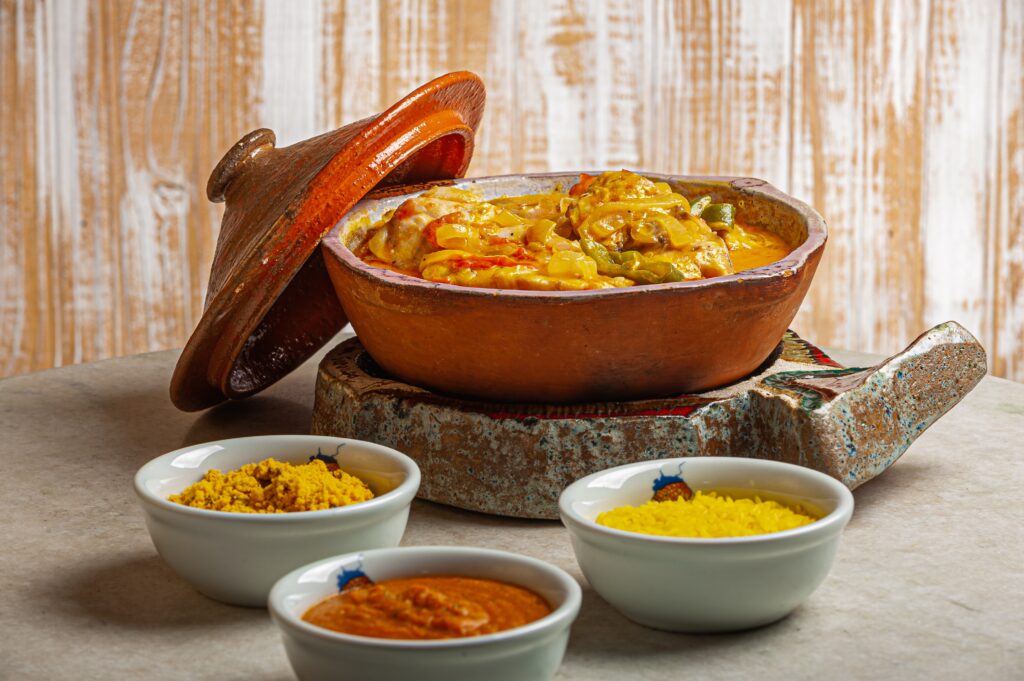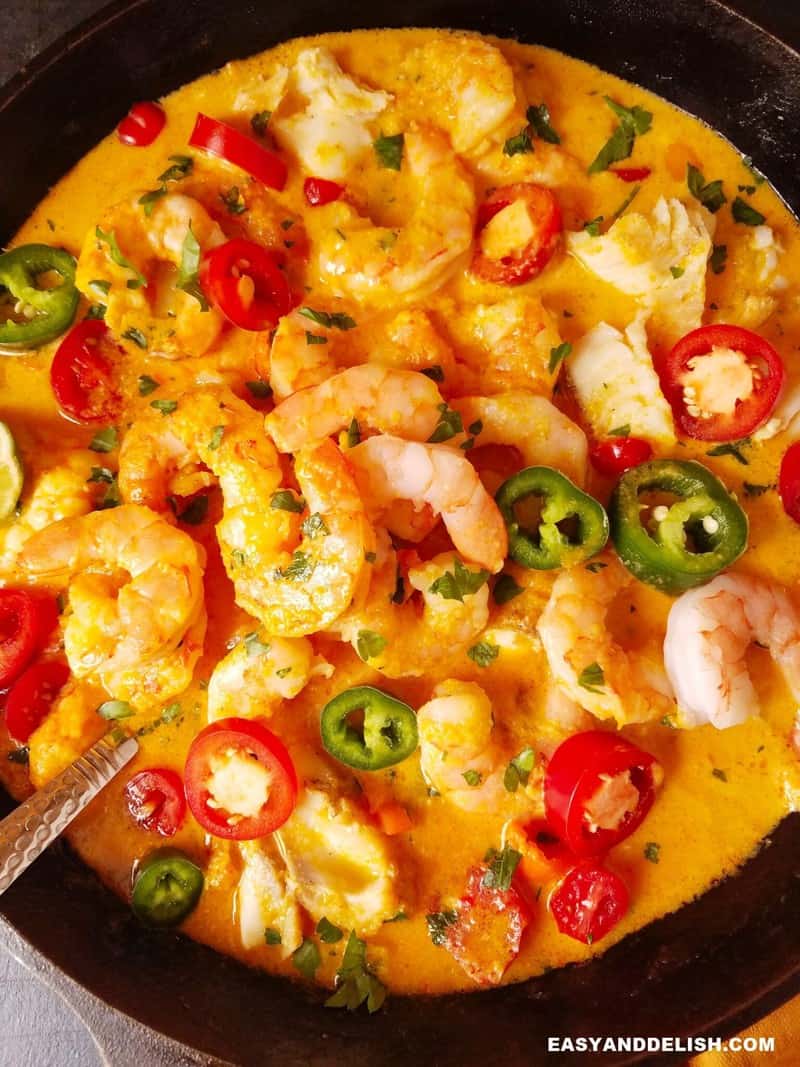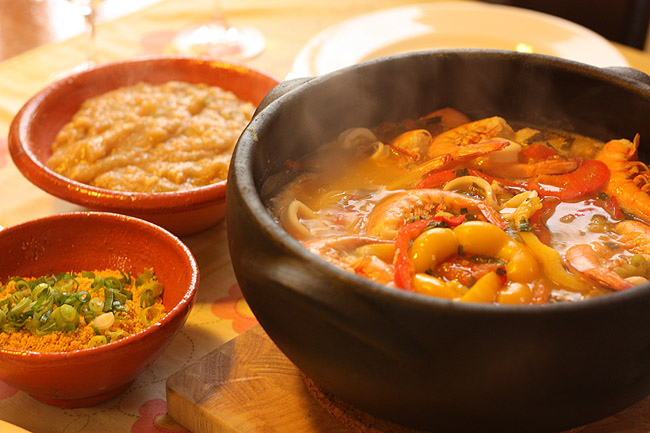A Dive into Moqueca: A Culinary Journey Through Brazil’s Coastal Delights
Related Articles
- A Dive Into The Delicious World Of Peruvian Ceviche: From Tradition To Innovation
- Karaage: A Crunchy Journey Through Japanese Flavors
- A Journey Through Flavor: Exploring The World Of Hummus, A Middle Eastern Culinary Treasure
- Panna Cotta: A Creamy Italian Delight
- A Feast For The Senses: The Story Of Peking Duck
Introduction
Discover everything you need to know about A Dive into Moqueca: A Culinary Journey Through Brazil’s Coastal Delights
A Dive into Moqueca: A Culinary Journey Through Brazil’s Coastal Delights

Moqueca, a vibrant and flavorful seafood stew, is a culinary treasure of Brazil, particularly the northeastern coastal regions. This dish embodies the essence of Brazilian cuisine, showcasing the harmonious blend of indigenous, African, and Portuguese influences. Its rich history, diverse variations, and irresistible taste have captivated palates for centuries, making moqueca a culinary icon both within Brazil and internationally.
A Tapestry of Flavors: The History and Origins of Moqueca
Moqueca’s origins can be traced back to the indigenous populations of Brazil, who had a long tradition of cooking fish in earthenware pots over an open fire. This technique, known as "moqueca," was adapted by Portuguese settlers who brought their own culinary influences, such as olive oil, onions, and garlic. The arrival of African slaves further enriched the dish, introducing ingredients like palm oil, coconut milk, and spices like dendê (palm oil) and pimentão (paprika).
This fusion of culinary traditions resulted in the moqueca we know today, a symphony of flavors that celebrates the diversity of Brazil’s cultural heritage.
The Essence of Moqueca: Key Ingredients and Techniques
Moqueca’s essence lies in its simplicity and the interplay of its core ingredients:
- Seafood: The star of the show, moqueca features a variety of seafood, most commonly fish like snapper, grouper, or cod, as well as shellfish like shrimp, mussels, or clams.
- Coconut Milk: A creamy and rich addition that adds a velvety texture and subtle sweetness.
- Palm Oil: Dendê, extracted from the African palm fruit, lends a vibrant orange hue and a distinctive nutty flavor.
- Onions, Garlic, and Tomatoes: These form the base of the sauce, creating a savory foundation for the dish.
- Spices: Pimentão (paprika), cumin, coriander, and other spices add depth and complexity to the flavor profile.
- Cilantro: A fresh and herbaceous garnish that brightens the dish.

Moqueca’s Culinary Evolution: From Traditional to Modern
Moqueca has evolved over time, adapting to regional preferences and modern culinary trends. While the traditional method involves cooking over an open fire in earthenware pots, modern adaptations utilize stovetops and cast-iron cookware.
Regional Variations: A Culinary Mosaic
Moqueca’s versatility is evident in its regional variations, each reflecting the local ingredients and culinary traditions:
- Moqueca Baiana: Originating in Bahia, this version is characterized by its use of dendê, shrimp, and a generous amount of spices, including pimenta malagueta (hot peppers).
- Moqueca Capixaba: From the state of Espírito Santo, this variation often features a combination of fish and shrimp, cooked in coconut milk with onions, garlic, and tomatoes.
- Moqueca Paulista: This variation from São Paulo incorporates regional ingredients like hearts of palm, cassava flour, and aji amarillo peppers.
Moqueca: A Culinary Experience Beyond the Plate

Beyond its deliciousness, moqueca offers a unique culinary experience. The dish is traditionally served in a communal pot, encouraging sharing and fostering a sense of togetherness. It’s a celebration of flavors, textures, and the spirit of Brazilian hospitality.
Mastering the Art of Moqueca: A Comprehensive Guide
To create a truly authentic moqueca, it’s essential to understand the nuances of each ingredient and technique. Here’s a step-by-step guide to crafting your own masterpiece:
1. Choosing the Right Seafood:
- Freshness is key: Opt for fresh, high-quality seafood, preferably caught locally.
- Fish selection: Snapper, grouper, cod, and other firm-fleshed fish are ideal.
- Shellfish options: Shrimp, mussels, and clams add a briny depth to the dish.
- Consider your preferences: Choose seafood that suits your taste and dietary needs.
2. Preparing the Ingredients:
- Cleaning and prepping: Thoroughly clean and prepare your seafood, removing scales, guts, and any unwanted parts.
- Marinating: Marinate the seafood in lime juice, salt, and pepper for a few minutes to enhance its flavor.
- Chopping the aromatics: Finely chop onions, garlic, and tomatoes, ensuring even cooking.
- Preparing the spices: Toast whole spices like cumin and coriander seeds to release their aromas, then grind them into a powder.
3. Crafting the Flavorful Base:
- Sautéing the aromatics: In a large pot, sauté onions, garlic, and tomatoes until softened and fragrant.
- Adding the spices: Incorporate your spice blend, ensuring even distribution.
- Deglazing: Deglaze the pot with a splash of white wine or water, scraping up any browned bits from the bottom.
4. Building the Creamy Coconut Base:
- Coconut milk: Add coconut milk to the pot, stirring to combine with the other ingredients.
- Simmering: Simmer the mixture until the coconut milk thickens slightly, creating a creamy sauce.
5. Cooking the Seafood:
- Adding the seafood: Gently add the marinated seafood to the pot, ensuring it’s submerged in the sauce.
- Simmering: Simmer the dish over low heat, allowing the seafood to cook through without overcooking.
- Checking for doneness: The fish should be opaque and flake easily with a fork.
6. Finishing Touches:
- Adding the dendê: Drizzle in dendê palm oil, ensuring it’s evenly distributed throughout the dish.
- Garnishing: Garnish with chopped cilantro, a squeeze of lime juice, and a pinch of salt and pepper.
7. Serving and Enjoying:
- Traditional serving: Serve moqueca in a communal pot, allowing guests to enjoy the dish together.
- Accompaniments: Serve moqueca with rice, farofa (toasted cassava flour), or a side salad.
- Enjoy the flavors: Savor the rich and complex flavors of the dish, appreciating the harmonious blend of ingredients and techniques.
Crafting Culinary Variations: Exploring the World of Moqueca
The beauty of moqueca lies in its adaptability. You can create a unique culinary experience by incorporating your own personal touches and preferences.
- Experiment with Seafood: Try different types of fish, shellfish, or even a combination of both.
- Spice It Up: Add more heat by incorporating chili peppers like pimenta malagueta or habanero.
- Incorporate Regional Ingredients: Add hearts of palm, cassava flour, aji amarillo peppers, or other local ingredients to reflect your region’s culinary traditions.
- Vegan Moqueca: Create a vegan version by substituting the seafood with tofu, mushrooms, or jackfruit.
- Modern Twist: Experiment with modern techniques like grilling the seafood before adding it to the pot or using a blender to create a smoother sauce.
Tips for Success:
- Don’t overcook the seafood: Overcooked seafood becomes dry and tough. Simmer it gently until cooked through.
- Use quality ingredients: Fresh seafood, good quality coconut milk, and authentic spices make a difference.
- Don’t be afraid to adjust the seasoning: Taste the dish as you cook and adjust the salt, pepper, and spices to your liking.
- Serve it hot: Moqueca is best enjoyed fresh and hot, allowing the flavors to fully develop.
- Enjoy the experience: Moqueca is more than just a dish; it’s a culinary journey that celebrates Brazil’s vibrant culture and diverse flavors.
Beyond the Plate: Moqueca’s Cultural Significance
Moqueca transcends its culinary role, holding a significant place in Brazilian culture. It’s a symbol of national pride, representing the fusion of indigenous, African, and Portuguese influences that have shaped the country’s identity. Moqueca is often served at special occasions, family gatherings, and festivals, bringing people together around a shared culinary experience.
Conclusion: A Culinary Legacy for Generations to Come
Moqueca is more than just a dish; it’s a culinary legacy that has been passed down through generations, evolving and adapting while maintaining its core essence. It’s a testament to the power of food to connect cultures, share stories, and create lasting memories. Whether you’re a seasoned chef or a culinary novice, exploring the world of moqueca is an adventure for the senses, a journey through Brazil’s rich culinary heritage. So, gather your ingredients, fire up your stove, and embark on your own moqueca adventure!
Closure
We hope this article has helped you understand everything about A Dive into Moqueca: A Culinary Journey Through Brazil’s Coastal Delights. Stay tuned for more updates!
Don’t forget to check back for the latest news and updates on A Dive into Moqueca: A Culinary Journey Through Brazil’s Coastal Delights!
Feel free to share your experience with A Dive into Moqueca: A Culinary Journey Through Brazil’s Coastal Delights in the comment section.
Keep visiting our website for the latest trends and reviews.






